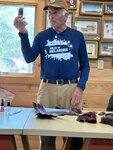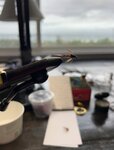I t’s the beginning of Autumn: the end of September heading into October, when the air is cooler, skies are clearer, trees start to color up, chilly mornings turn to warm sunny afternoons and …
This item is available in full to subscribers.
Please log in to continue |


It’s the beginning of Autumn: the end of September heading into October, when the air is cooler, skies are clearer, trees start to color up, chilly mornings turn to warm sunny afternoons and we love to spend as much time out of doors as possible.
It is also the time of year when the Isonychia Bicolor mayflies are found in abundance; although they hatch in May through July in some streams, they are especially prolific in the month of September heading into October. We have had a number of memorable September fishing dates
during hatches of the Isonychia.
These mayflies can be extremely prolific; at times the nymphs, which are fast-swimming, can be present in the thousands, swimming to shallow water along the edge and leaving their nymphal cases or shucks behind, lining rocks and gravel along shore. These tell-tale signs enable fly-fishers to be able to identify the flies from other mayflies that are hatching. The Isonychia are unusually colored, with brown forelegs and light yellowmiddle and rear legs; the wings are dark dun and the body is long and of a reddish brown.
Not as large as the Green Drake, they are still a good-sized fly, similar in size to a March Brown, and are an important species that is popular with Catskill fly-fishers. They are often associated with the early Catskill fly-tier
Art Flick, of West Kill, author of the best-selling “Streamside Guide”, who
created the Dun Variant dry fly to imitate the Isonychia. Art wrote that his Dun Variant was a “killing pattern” and he never knew it to fail when fished during an Isonychia hatch. There are a number of patterns tied to imitate the various stages of the Isonychia’s life cycle: the immature nymph stage, the adult stage dun that floats on the water, and the adult after mating spinner stage that falls back to the water’s surface. The dun is easiest to fish with and is often most successful, as the duns ride the water’s surface longer and are more prolific than the spinners, which are often eaten by birds or hit by cars, splattering on their windshields.
Last Saturday, the Catskill Fly Tyers Guild held their first meeting and tying session of the fall season at the Catskill Fly Fishing Center’s RodBuilding Shop and the topic was Isonychia. CFTGuild Vice President, John Apgar, demonstrated how to tie two of his favorite Isonychia patterns, a Turkey Quill Iso Parachute pattern, and a Turkey Quill pattern tied with EP
Trigger Point fibers.
Earlier in the month, John held a three-hour demonstration at Dette Flies, Livingston Manor, on Dying Natural Materials, using coffee, for
example, to dye certain feathers; he brought along several dyed turkey quills which he offered to each member to take home and tie with.
Here are two of John’s favorite patterns he uses with success during the Isonychia hatch:
Iso Parachute
Hook: #12 Dry fly hook
Tail: Dark Dun
Body: Dyed Mahogany Brown Wild Turkey Boit fiber from the wide side of the feather
Post: Dark Dun Trigger Point material
Hackle: Dark Dun
Iso Comparadun
Hook : #12 Standard dry fly
Tail: Dark Dun tied in splayed out
Body: Dyed Mahogany Wild Turkey wide side Boit
Wing: Dark Dun Trigger Point
Thorax: Mahogany Brown Dyed Beaver/Red Fox blend
And an “artificial Coachman” Nymph pattern created by Preston Jennings
for use during the Isonychia hatch, tied in the Catskill Style way back in the
1930s that Ed and I are enjoying tying:
Hook: #8 or #9 Sproat
Tail: Brown Partridge
Body: Mixture of claret and dark red seal’s fur
Thorax: Peacock herl
Ribbing: Round gold tinsel
Hackle: a few turns of red or furnace cock’s hackle
Comments
No comments on this item Please log in to comment by clicking here